From the January 2022 issue of Apollo. Preview and subscribe here.
Many – if not all – artists eventually acquire origin stories, formative experiences to which all their subsequent artistic achievements can plausibly be traced. Tony Smith had his night-time drive on the unfinished New Jersey Turnpike; Louise Bourgeois had her father’s affair; Andy Warhol had his time drawing ads for shoes. Such stories become more meaningful as they recede in time, ossifying with use and reuse.
Howardena Pindell has hers too. She was born in 1943 in Philadelphia, into a middle-class Black household. Her father, trained as a mathematician, worked as a court administrator and her mother, a historian, was an elementary school teacher. Pindell read a lot and visited Philadelphia’s many museums, especially after a teacher recognised her talent for drawing and painting. Marcel Duchamp’s birdcage filled with marble cubes, Why Not Sneeze, Rose Sélavy? (1921), at the Philadelphia Museum of Art, was a particular favourite.
One day in the early 1950s, the Pindells took a trip to visit Howardena’s grandmother in Ohio. While her mother was catching up with her family, Pindell and her father drove into Kentucky, where they stopped at the side of the road for a root beer, a drink of which her father was particularly fond. The young Howardena asked him why their chilled mugs had large red circles underneath. Her father explained that these dots prevented the mugs being mixed up with the otherwise identical mugs reserved for white customers. The circle – a shape that has recurred in Pindell’s art across diverse media over the past half-century – was indelibly associated in the young girl’s mind with prejudice and racial insult.
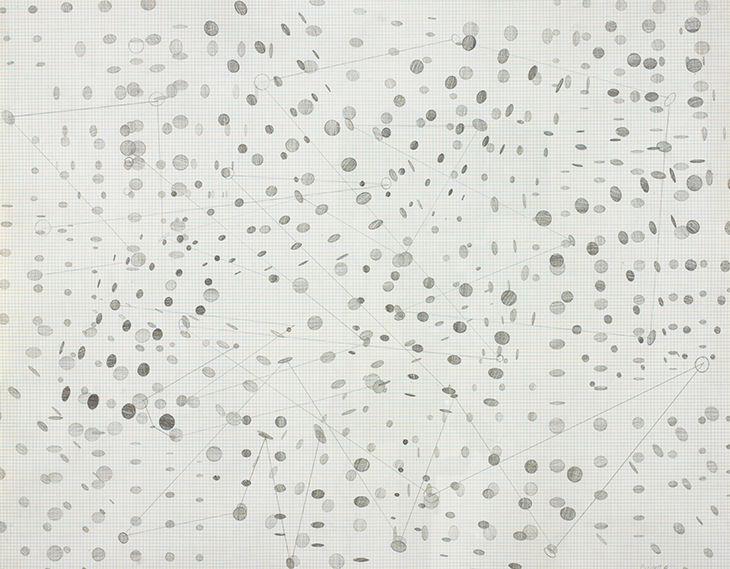
Space Frame (1968), Howardena Pindell. RISD Museum, Providence. Courtesy the artist, Garth Greenan Gallery, New York and Victoria Miro, London/Venice; © Howardena Pindell
But, Pindell tells me by phone from her studio in New York, she wasn’t thinking about root beer when she first began drawing and painting circles on to her canvases in the late 1960s. A recent MFA graduate from Yale – where she was one of only a handful of female students – she had transitioned from figurative painting to abstraction, then the dominant mode at the school. In an untitled pastel drawing from 1968, Pindell hangs roughly rendered squares, diamonds, circles and ellipses on an irregular grid. In Space Frame, a very different work from the same year betraying the influence of Larry Poons, she arrays neat circles and ellipses on graph paper using a pencil and a store-bought stencil. Soon after, she began cutting her own stencils with a hole-punch, and spraying acrylic paint through them. Not long after that, she found she could use the punched card discs in the paintings too, scattering them on like confetti.
It is striking how quickly Pindell arrived at paintings that, today, seem wholly formed, prescient of her later discoveries and remarkably mature for such a young artist. Despite significant digressions into other media and styles, not to mention abrupt gear shifts into other conceptual strategies and registers of language, it is to gorgeous abstractions made from drifts of coloured discs that Pindell has repeatedly returned.
A number of institutional survey exhibitions have brought what’s distinctive about her work into clearer focus in the past three years, beginning with the extensive ‘What Remains to be Seen’, at the Museum of Contemporary Art, Chicago, and now complemented in the UK by ‘Howardena Pindell: A New Language,’ which opened at Fruitmarket, Edinburgh, in November 2021 (until 2 May) and which will travel to Kettle’s Yard, Cambridge, and Spike Island, Bristol, in 2022 and 2023.
What is also striking about Pindell’s output, over the decades, is how its reception – and even its meaning – has changed. ‘It has taken years for people to be able to read my work,’ she says. ‘And now it’s like I’m some kind of superstar! It’s very weird.’
In her early paintings Pindell was navigating the artistic hegemony of the time: hard-edged, grid-based minimalism – which, whether she consciously articulated it or not in her work, was synonymous with white masculinity. When she landed in New York City after her studies in New Haven, she recalls encountering ‘an all-white-male art world’. It seemed to her that the only women artists who received attention ‘were either the child, the lover or in some kind of relationship with a famous white male artist’. For artists of colour, opportunities were even more limited. ‘It was not pleasant,’ Pindell says. ‘If a Black person walked into a gallery, you knew they didn’t want you there.’
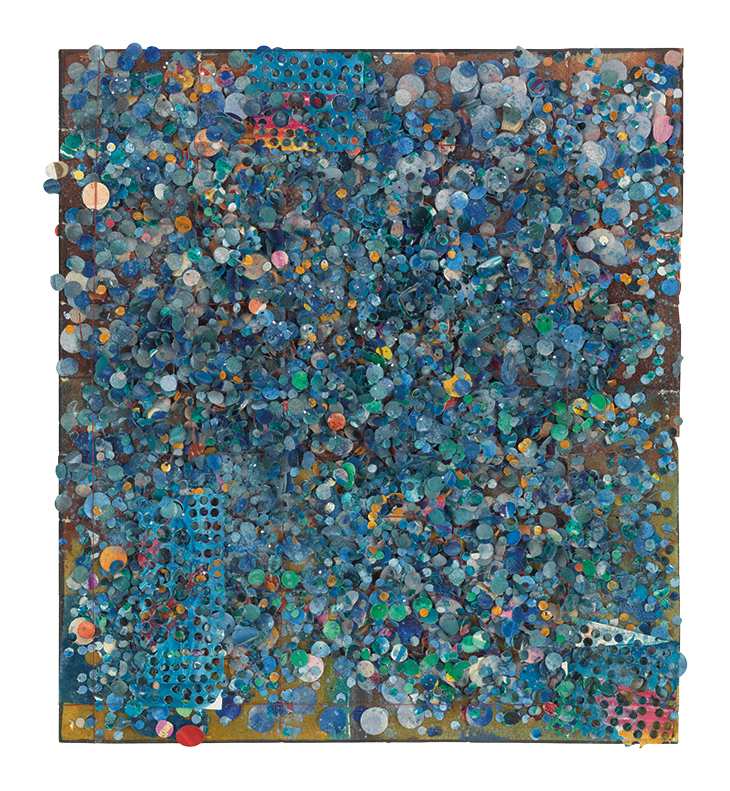
Untitled #98 (1978), Howardena Pindell. Courtesy the artist, Garth Greenan Gallery, New York and Victoria Miro, London/Venice; © Howardena Pindell
Pindell found herself underserved even by those quarters of the artistic community where she might have expected to find kinship and support. The Black Arts Movement, which had its roots in Harlem, was dominated by men, and hewed to the belief that art made by Black artists should reflect their lived experience, not just their subjectivity. As with other Black abstract artists who made no political claims for their art, Pindell was ostracised by the Black Arts Movement in the 1970s for making work that might equally (or so it seemed) have been made by a white artist.
Pindell denies, too, that she particularly thought of her paintings in terms of her gender at this time, despite using unconventional media such as thread, glitter, sequins, talcum powder, cat hair and perfume. ‘I just see being an artist as a way of being playful,’ she says. With works that subverted the rigidity of the grid with pliable thread or, as in Untitled (1968–70), with ropes made from rolled canvas that drape on to the floor, like many other post-minimalist artists of the time, Pindell prioritised softness and responsiveness over permanence and mathematical certainty. Her work was unabashedly beautiful, sensuous and experiential, rather than discursive, conceptual or literal.
For these reasons, perhaps, Pindell found, for a time, an affinity with the women’s movement, which these days she dryly refers to as the ‘white women’s movement’. In 1972 she was a founding member, along with artists including Harmony Hammond, Nancy Spero, Sari Dienes and Ree Morton, of A.I.R. Gallery, the first all-female artists’ cooperative gallery in the United States. (Pindell came up with the name, which derived from Jane Eyre, but which also stood for ‘artists in residence’ – the official designation that permitted industrial SoHo lofts to be inhabited by artists.) Pindell was the only artist of colour in the gallery, and whenever she brought up issues of race in meetings, her objections were either ignored or openly derided. ‘One of the women in the gallery would say for years in meetings that I didn’t know I was Black!’ Pindell says. I ask her what she meant by that. ‘Probably, because I had a good education, I had a good job. And I spoke with strength. I wasn’t obsequious. I wasn’t bending the knee to her,’ she replies. ‘Whatever.’ She quit the gallery in 1975.
Pindell did indeed have a good job, at the time. She was the Museum of Modern Art’s first Black curator – rising to the position of Associate Curator of Prints and Illustrated Books by 1977. The museum was something of a gilded cage; while it placed her near the centre of the institutional art world in the United States, she nevertheless found herself marginalised and condescended to by curatorial colleagues. She remembers one occasion when her white female colleagues were striking over conditions at the museum. Despite their entreaties, she refused to join them. ‘I don’t have a husband who has a job! I have to pay for everything. I can’t afford to get fired!’ she told them. Meanwhile, when she attended meetings with the Art Workers’ Coalition, an activist organisation that was pressuring MoMA to implement greater racial and gender equality, she found that other members of the group regarded her with suspicion because of her job.
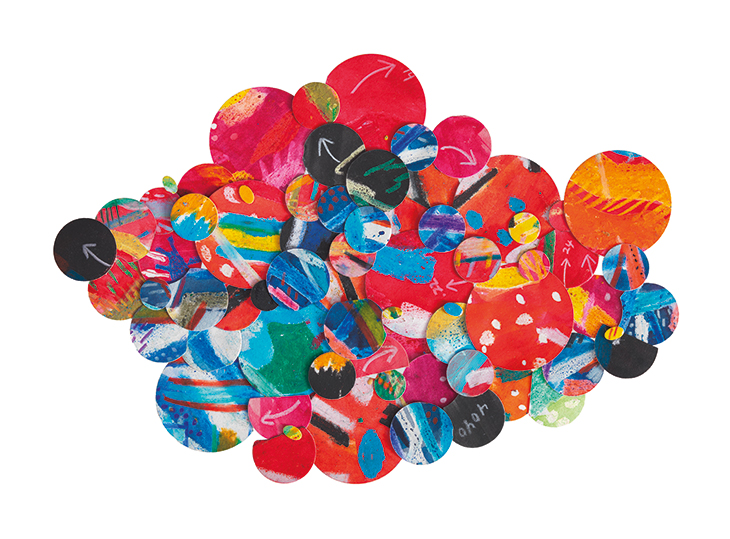
Untitled 4#D (2009), Howardena Pindell. Courtesy the artist, Garth Greenan Gallery, New York and Victoria Miro, London/Venice; © Howardena Pindell
In February 1979, Artists Space – the publicly funded downtown New York venue for emerging art that is thriving still today – held an exhibition by the young artist Donald Newman titled ‘The Nigger Drawings’. An ‘emergency coalition’ protested outside the gallery, and a letter of complaint signed by Lucy Lippard, Carl Andre, Faith Ringgold and Pindell, among others, was delivered to Helene Winer, the gallery’s director. To the surprise of many, and to the bitter disappointment of Pindell, the protests were met with vocal support for Artists Space, and for Newman’s right to freedom of speech. Among the signatories of an open letter in defence of the exhibition’s title were critics Rosalind Krauss, Douglas Crimp, Roberta Smith and Craig Owens. ‘They saw any criticism of a white male artist as censorship, but they did not see that men and women of colour, and white women, were not in the system,’ Pindell says. ‘They were censored out of it.’
Despairing at the systemic racism of the art world, Pindell resigned from MoMA later that year. She took up a professorship at Stony Brook University, in Long Island, which honoured her in 2019 as a Distinguished Professor, and where she teaches to this day. One morning in October 1979, she took a lift to school with her colleague Donald Kuspit, and their car was hit by another driver. Pindell’s bodily injuries, though severe, healed faster than the brain injuries she suffered; for months afterwards, she found her memory impaired and her emotions sensitised. This brush with her own mortality had a profound effect on her. Suddenly, she felt an urgency to convey in her work the social conditions she experienced and the tribulations she was forced to endure. ‘I felt if I didn’t tell people what I was going through, or what I was thinking or feeling, I could be in another accident and die, and no one else would know,’ she says.
Free, White and 21 (1980) is the performance video that Pindell made in the wake of her accident. Its bitterly ironic title recalls an old-fashioned colloquialism used by white Americans meaning ‘beholden to no one’. In it, Pindell relates various instances of racism she had experienced throughout her life, from early childhood through college to adulthood, intercut with responses from a white woman – actually Pindell disguised in whiteface. ‘You ungrateful little […] after all we have done for you,’ the white character seethes. ‘You know we don’t believe in your symbols, they are not valid unless we validate them. And you really must be paranoid. I have never had experiences like that. But, of course, I am free, white, and 21.’
The video remains notorious: an aberration in Pindell’s oeuvre up to that moment which was not, until very recently, repeated – ‘I’m not a video artist. I am basically just a painter,’ she tells me – but which galvanised everything around it. When included in her 1993–94 travelling retrospective, the video tape of Free, White and 21 was stolen from Cleveland Institute of the Arts; at Georgia State University, in Atlanta, the exhibition was threatened with closure because of it.
Mild, in comparison, are the Autobiography paintings that Pindell made in the mid 1980s. Soon after her car accident, figures began to appear in her work, first in found photographs that she collaged into her paintings, and then as a direct tracing of Pindell’s own body. In Autobiography: Water (Ancestors/Middle Passage/Family Ghosts) (1988), for instance, several outlines of the artist’s body and a painted portrait of her face float on a watery blue surface past newspaper and magazine images of eyes and faces, transferred snippets of text, and an outline of the famous 18th-century diagram of the Brooks slave ship.
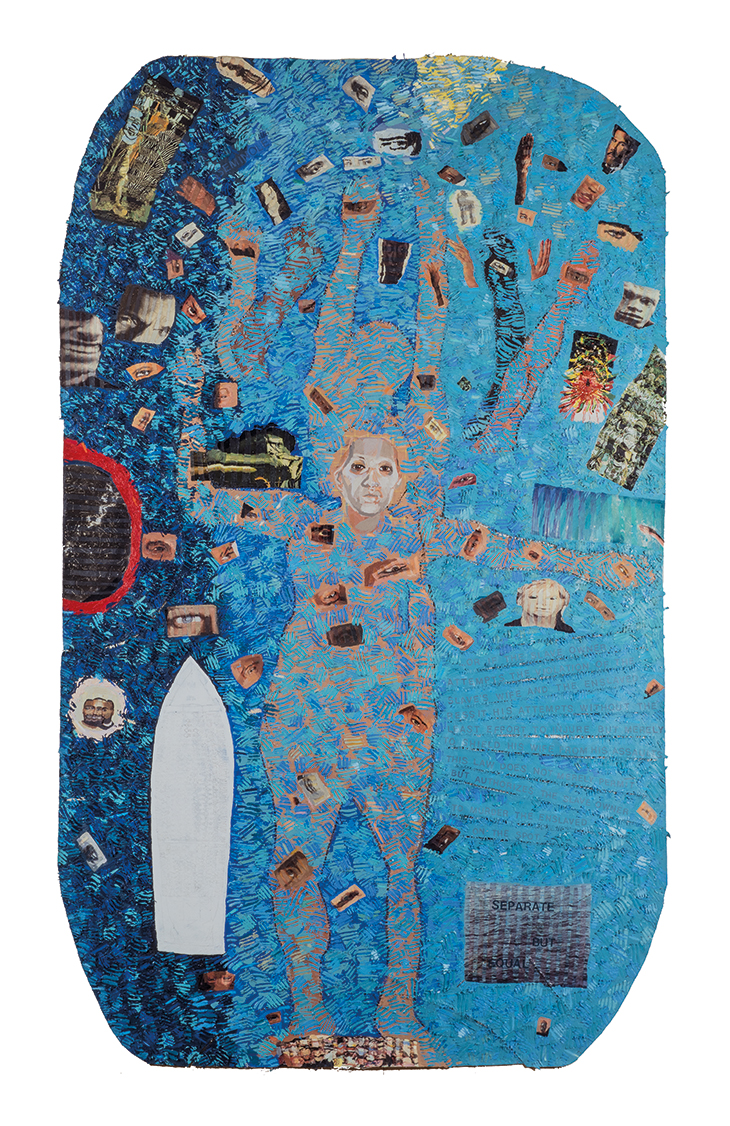
Autobiography: Water (Ancestors/Middle Passage/Family Ghosts) (1988), Howardena Pindell. Wadsworth Atheneum, Hartford. Courtesy the artist, Garth Greenan Gallery, New York and Victoria Miro, London/Venice; © Howardena Pindell
The Autobiography series opened up the possibility, in Pindell’s work, for memory and imaginative projection to intermingle with historical data, textual information and photographs. From the 1970s onwards, Pindell travelled widely, including a research trip through parts of Africa in 1973 with the curator Lowery Stokes Sims. Her photographs from these trips appear throughout the Autobiography works, often sliced apart and filled in with paint.
Pindell has always maintained a somewhat ambiguous relationship in her work with data – especially with numbers, which appear early on in her paintings. In the most extreme examples from the early 1970s, she penned numbers on to tiny hole-punched chads and then fixed them, out of sequence, in a tight grid on a piece of paper. In her series of Video Drawings (1973–76), numbered arrows chaotically cover images photographed from her television. These works approach what Kant called ‘the mathematical sublime’ – the sense of something impossibly huge that can be apprehended not by our sensual faculties, but by the reasoned application of data. In her number works, Pindell is reaching towards subjects that are enormous, beyond the scale of our individual bodies, but which can be approached only through the body – in this instance, through the labour of numbering and counting.
After an intermission of 40 years, in 2020 Pindell presented a second video work, Rope/Fire/Water (2020) at the Shed in New York. In the video, we hear her reading an almost unbearable succession of statistics and information related to the history of racist lynching in the United States. Her voice occasionally cracks at the atrocious violence she describes. Rope/Fire/Water concludes with a list of known victims of police violence between 2015 and 2020, pressing the point that these instances of brutality against Black bodies are not confined to the past. With the exception of occasional archival photographs, the screen remains black through most of the film.
Today, Pindell is entirely comfortable with the bifurcation of her practice. She says that recent events, including the killings by police of Black men, women and children, have ‘drained the colour out of my issue-related work. Colour is now used only for abstract work’. Alongside Rope/Fire/Water at the Shed were curvaceous, abstract canvases such as the mint-green Plankton Lace #1 (2020; Fig. 7), as well as two predominantly black, predominantly text-based pieces titled Four Little Girls and Columbus (both 2020). The latter, especially shocking, included a pile of cast black hands beneath text that described the vicious colonial practice of cutting off the hands of indigenous people.
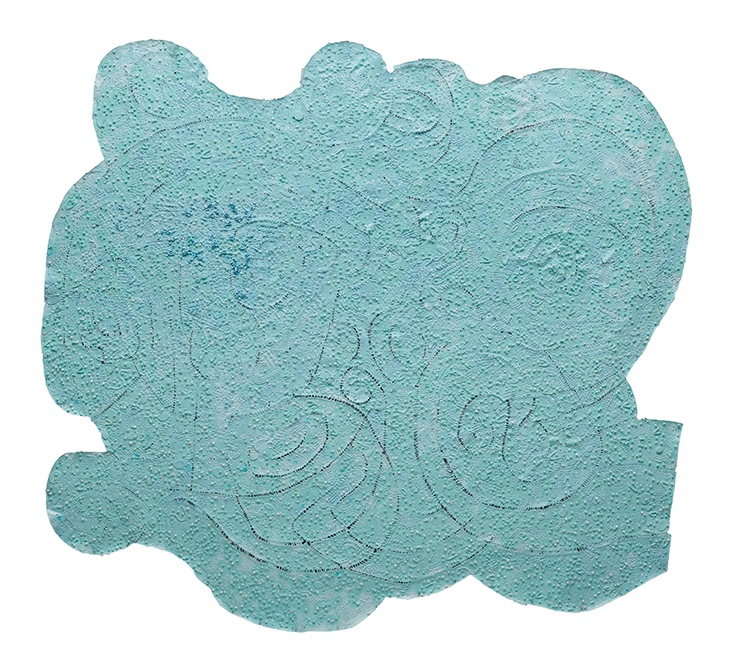
Plankton Lace #1 (2020), Howardena Pindell. Courtesy the artist, Garth Greenan Gallery, New York and Victoria Miro, London/Venice; © Howardena Pindell
However the artist thinks of it, I would suggest that there is less of a split in Pindell’s work than it might seem. Plankton Lace #1, for example, was inspired by global warming and the crucial role of oceanic life (plankton produces more than 50 per cent of the planet’s oxygen). As a child, Pindell liked to peer through her microscope at the tiny life forms swimming about in Philadelphia drinking water. She has spent time at sea, both during her travels and while deep-sea fishing with her father. Plus, she adds, ‘I will never forget the Middle Passage and slavery.’
That story about the root beer mug isn’t just about the traumas and humiliations that were normalised for Black people in the Jim Crow South. Pindell has a thousand other such stories, most of them much more recent. It’s about how any form – even something as pure and elemental as the circle – can be polluted with the all-pervasive reality of racism in the United States. Pindell has other associations with the circle, of course, some of them more benign – the lotto scratch cards she remembers from childhood, for instance – and others more painful, such as the numbered tags once worn by slaves. Abstraction is never neutral or universal, never free from the attachment of histories both personal and shared, as Pindell has long made plain.
‘Howardena Pindell: A New Language’ is at Fruitmarket Gallery, Edinburgh, from 13 November 2021–2 May.
From the January 2022 issue of Apollo. Preview and subscribe here.
Unlimited access from just $16 every 3 months
Subscribe to get unlimited and exclusive access to the top art stories, interviews and exhibition reviews.

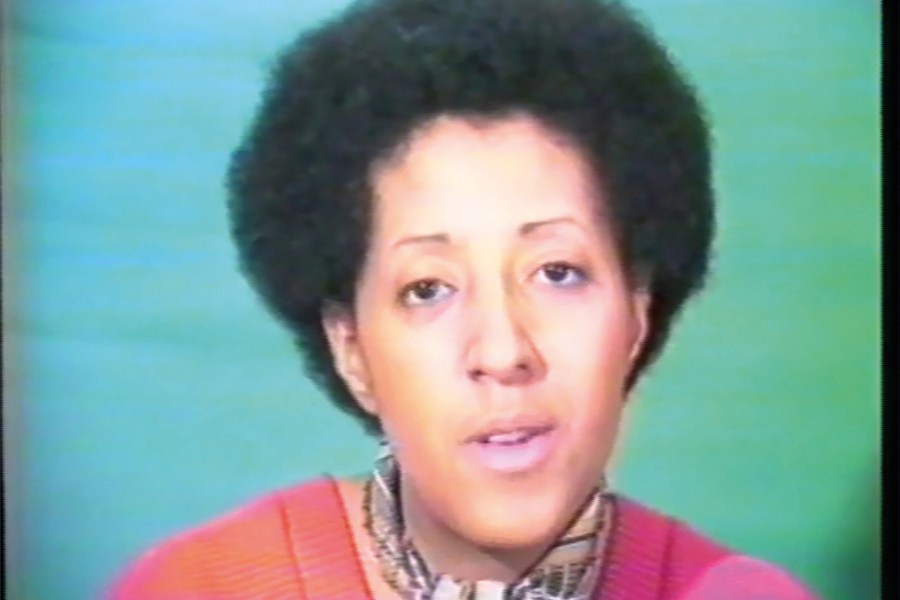
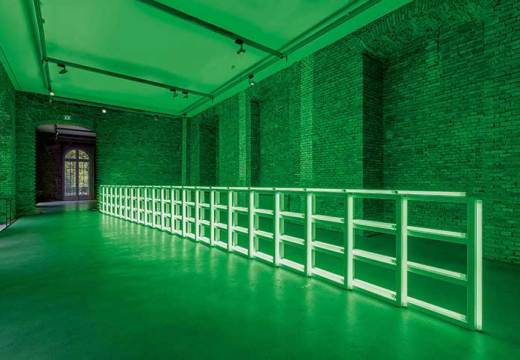
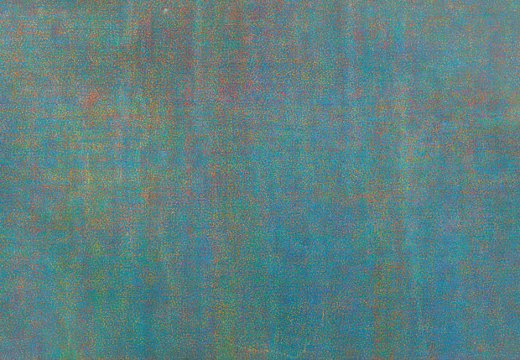
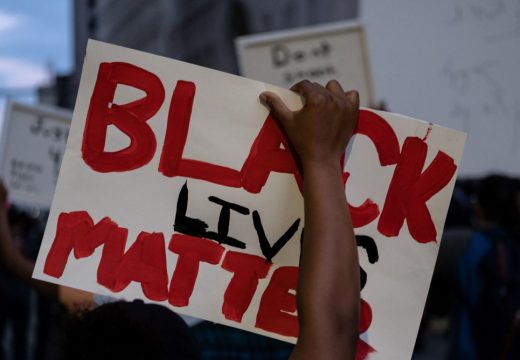









![Masterpiece [Re]discovery 2022. Photo: Ben Fisher Photography, courtesy of Masterpiece London](http://www.apollo-magazine.com/wp-content/uploads/2022/07/MPL2022_4263.jpg)
It’s time for the government of London to return to its rightful home